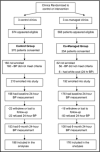Physician-pharmacist co-management and 24-hour blood pressure control
- PMID: 23614849
- PMCID: PMC3641686
- DOI: 10.1111/jch.12077
Physician-pharmacist co-management and 24-hour blood pressure control
Abstract
The objectives of this study were to compare indices of 24-hour blood pressure (BP) following a physician-pharmacist collaborative intervention and to describe the associated changes in antihypertensive medications. This was a secondary analysis of a prospective, cluster-randomized clinical trial conducted in 6 family medicine clinics randomized to co-managed (n=3 clinics, 176 patients) or control (n=3 clinics, 198 patients) groups. Mean ambulatory systolic BP (SBP) was significantly lower in the co-managed vs the control group: daytime BP 122.8 mm Hg vs 134.4 mm Hg (P<.001); nighttime SBP 114.8 mm Hg vs 123.7 mm Hg (P<.001); and 24-hour SBP 120.4 mm Hg vs 131.8 mm Hg (P<.001), respectively. Significantly more drug changes were made in the co-managed than in the control group (2.7 vs 1.1 changes per patient, P<.001), and there was greater diuretic use in co-managed patients (79.6% vs 62.6%, P<.001). Ambulatory BPs were significantly lower for the patients who had a diuretic added during the first month compared with those who never had a diuretic added (P<.01). Physician-pharmacist co-management significantly improved ambulatory BP compared with the control group. Antihypertensive drug therapy was intensified much more for patients in the co-managed group.
© 2013 Wiley Periodicals, Inc.
Figures
Similar articles
-
Pharmacist-physician comanagement of hypertension and reduction in 24-hour ambulatory blood pressures.Arch Intern Med. 2010 Oct 11;170(18):1634-9. doi: 10.1001/archinternmed.2010.349. Arch Intern Med. 2010. PMID: 20937921 Free PMC article. Clinical Trial.
-
Primary care-based, pharmacist-physician collaborative medication-therapy management of hypertension: a randomized, pragmatic trial.Clin Ther. 2014 Sep 1;36(9):1244-54. doi: 10.1016/j.clinthera.2014.06.030. Epub 2014 Jul 30. Clin Ther. 2014. PMID: 25085406 Free PMC article. Clinical Trial.
-
Physician and pharmacist collaboration to improve blood pressure control.Arch Intern Med. 2009 Nov 23;169(21):1996-2002. doi: 10.1001/archinternmed.2009.358. Arch Intern Med. 2009. PMID: 19933962 Free PMC article. Clinical Trial.
-
The impact of a multidisciplinary information technology-supported program on blood pressure control in primary care.Circ Cardiovasc Qual Outcomes. 2009 May;2(3):170-7. doi: 10.1161/CIRCOUTCOMES.108.823765. Epub 2009 May 5. Circ Cardiovasc Qual Outcomes. 2009. PMID: 20031834 Clinical Trial.
-
Long-term Outcomes of the Effects of Home Blood Pressure Telemonitoring and Pharmacist Management on Blood Pressure Among Adults With Uncontrolled Hypertension: Follow-up of a Cluster Randomized Clinical Trial.JAMA Netw Open. 2018 Sep 7;1(5):e181617. doi: 10.1001/jamanetworkopen.2018.1617. JAMA Netw Open. 2018. PMID: 30646139 Free PMC article. Clinical Trial.
Cited by
-
Pharmacist intervention for blood pressure control: medication intensification and adherence.J Am Soc Hypertens. 2015 Jul;9(7):569-78. doi: 10.1016/j.jash.2015.05.005. Epub 2015 May 15. J Am Soc Hypertens. 2015. PMID: 26077795 Free PMC article. Clinical Trial.
-
The evolving clinical management of hypertension.J Clin Hypertens (Greenwich). 2014 Dec;16(12):917-24. doi: 10.1111/jch.12444. Epub 2014 Nov 10. J Clin Hypertens (Greenwich). 2014. PMID: 25382794 Free PMC article. No abstract available.
-
Interprofessional collaboration in primary care: what effect on patient health? A systematic literature review.BMC Prim Care. 2023 Nov 29;24(1):253. doi: 10.1186/s12875-023-02189-0. BMC Prim Care. 2023. PMID: 38031014 Free PMC article.
-
Interprofessional collaboration to improve professional practice and healthcare outcomes.Cochrane Database Syst Rev. 2017 Jun 22;6(6):CD000072. doi: 10.1002/14651858.CD000072.pub3. Cochrane Database Syst Rev. 2017. PMID: 28639262 Free PMC article.
-
Cluster-randomized trial of a physician/pharmacist collaborative model to improve blood pressure control.Circ Cardiovasc Qual Outcomes. 2015 May;8(3):235-43. doi: 10.1161/CIRCOUTCOMES.114.001283. Epub 2015 Mar 24. Circ Cardiovasc Qual Outcomes. 2015. PMID: 25805647 Free PMC article. Clinical Trial.
References
-
- Yoon PW, Gillespie CD, George MG, Wall HK. Control of hypertension among adults–national health and nutrition examination survey, United States, 2005–2008. MMWR Morb Mortal Wkly Rep. 2012;61(suppl):19–25. - PubMed
-
- Wolf‐Maier K, Cooper RS, Banegas JR, et al. Hypertension prevalence and blood pressure levels in 6 European countries, Canada, and the United States. JAMA. 2003;289:2363–2369. - PubMed
-
- Lloyd‐Jones D, Adams RJ, Brown TM, et al. Executive summary: heart disease and stroke statistics–2010 update: a report from the American Heart Association. Circulation. 2010;121:948–954. - PubMed
-
- Heidenreich PA, Trogdon JG, Khavjou OA, et al. Forecasting the future of cardiovascular disease in the United States: a policy statement from the American Heart Association. Circulation. 2011;123:933–944. - PubMed
Publication types
MeSH terms
Substances
Grants and funding
LinkOut - more resources
Full Text Sources
Other Literature Sources
Medical


